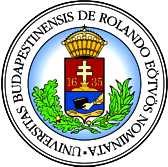University of Pest
| Eötvös Loránd Tudományegyetem (Hungarian) | |
 |
|
| Latin: Universitas Budapestinensis de Rolando Eötvös nominata | |
| Motto | Community of Knowledge |
|---|---|
| Type | Public research university |
| Established | 1635 |
| Affiliation | |
| Chancellor | Dr. Gyula Scheuer |
| Rector | Barna Mezey, D.Sc |
|
Academic staff
|
1,800 |
| Undergraduates | 16,017 |
| Postgraduates | 8,547 |
| 1,442 | |
| Location |
47°29′26″N 19°03′31″E / 47.4906°N 19.0585°ECoordinates: 47°29′26″N 19°03′31″E / 47.4906°N 19.0585°E |
| Campus | Urban |
| Website | www |
| University rankings | |
|---|---|
| Global | |
| ARWU | 301-400 |
| Times | 401- |
| QS | 551-600 |
Eötvös Loránd University (Hungarian: Eötvös Loránd Tudományegyetem, ELTE) is a Hungarian public research university based in Budapest. Founded in 1635, ELTE is one of the largest and the most prestigious public higher education institutions in Hungary. The 28,000 students at ELTE are organized into eight faculties, and into research institutes located throughout Budapest and on the scenic banks of the Danube. ELTE is affiliated with 5 Nobel laureates, as well as winners of the Wolf Prize, Fulkerson Prize and Abel Prize, the latest of which was Abel Prize winner Endre Szemerédi in 2012.
The predecessor of Eötvös Loránd University was founded in 1635 by cardinal Péter Pázmány as a catholic university for teaching theology and philosophy. In 1770, the University was transferred to Buda, and with the support of Maria Theresa, Empress of Austria and Queen of Hungary, became the Royal Hungarian University. It was named Royal University of Pest until 1873, then University of Budapest until 1921, when it was renamed Pázmány Péter University after its founder Péter Pázmány. The Faculty of Science started its autonomous life in 1949 when The Faculty of Theology was separated from the university. The university received its current name in 1950, after one of its most well-known physicists, Baron Loránd Eötvös.
The university was founded in 1635 in Nagyszombat, Kingdom of Hungary, (today Trnava, Slovakia) by the archbishop and theologian Péter Pázmány. Leadership was given over to the Jesuits. Initially the university only had two colleges (College of Arts and College of Theology). The College of Law was added in 1667 and the College of Medicine was started in 1769. After the dissolution of the Jesuit order, the university was moved to Buda (today part of Budapest) in 1777 in accordance with the intention of the founder. The university moved to its final location in Pest (now also part of Budapest) in 1784. The language of education was Latin until 1844, when Hungarian was introduced as an official language. Women have been allowed to enroll since 1895.
...
Wikipedia
